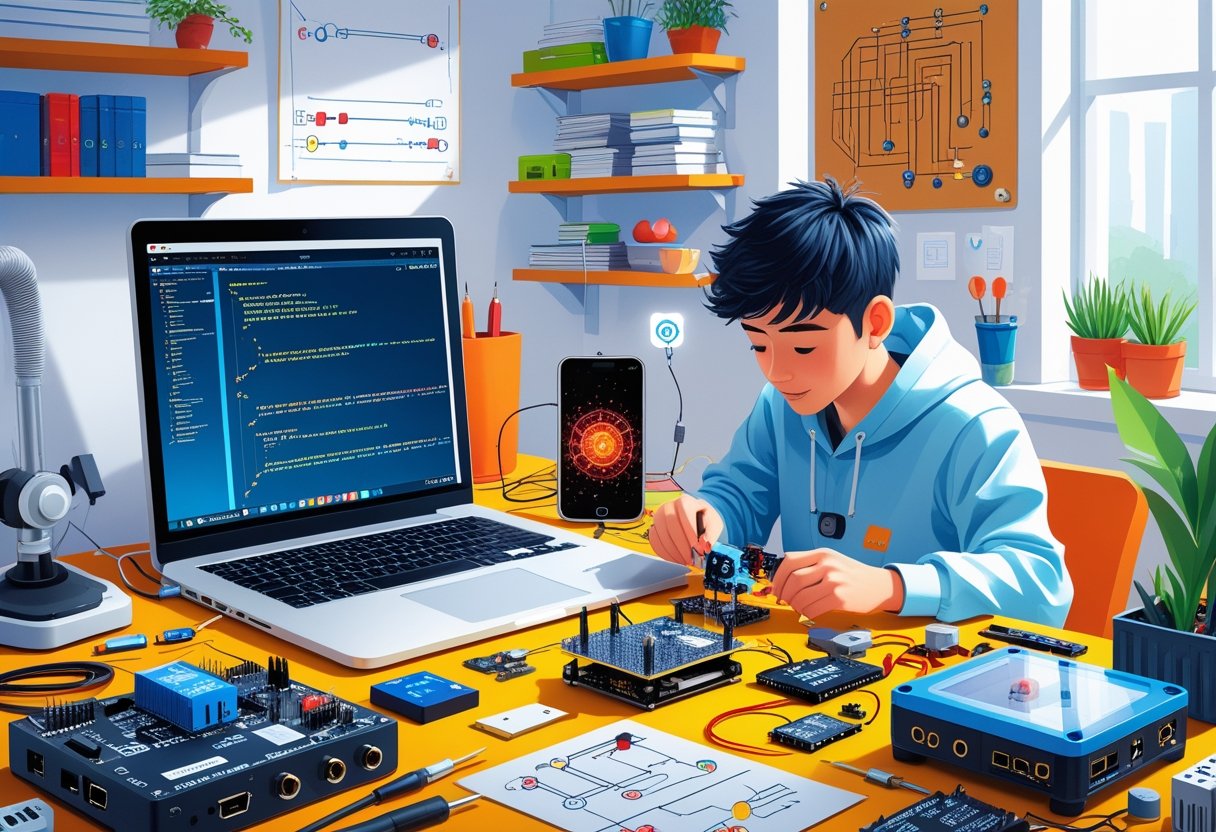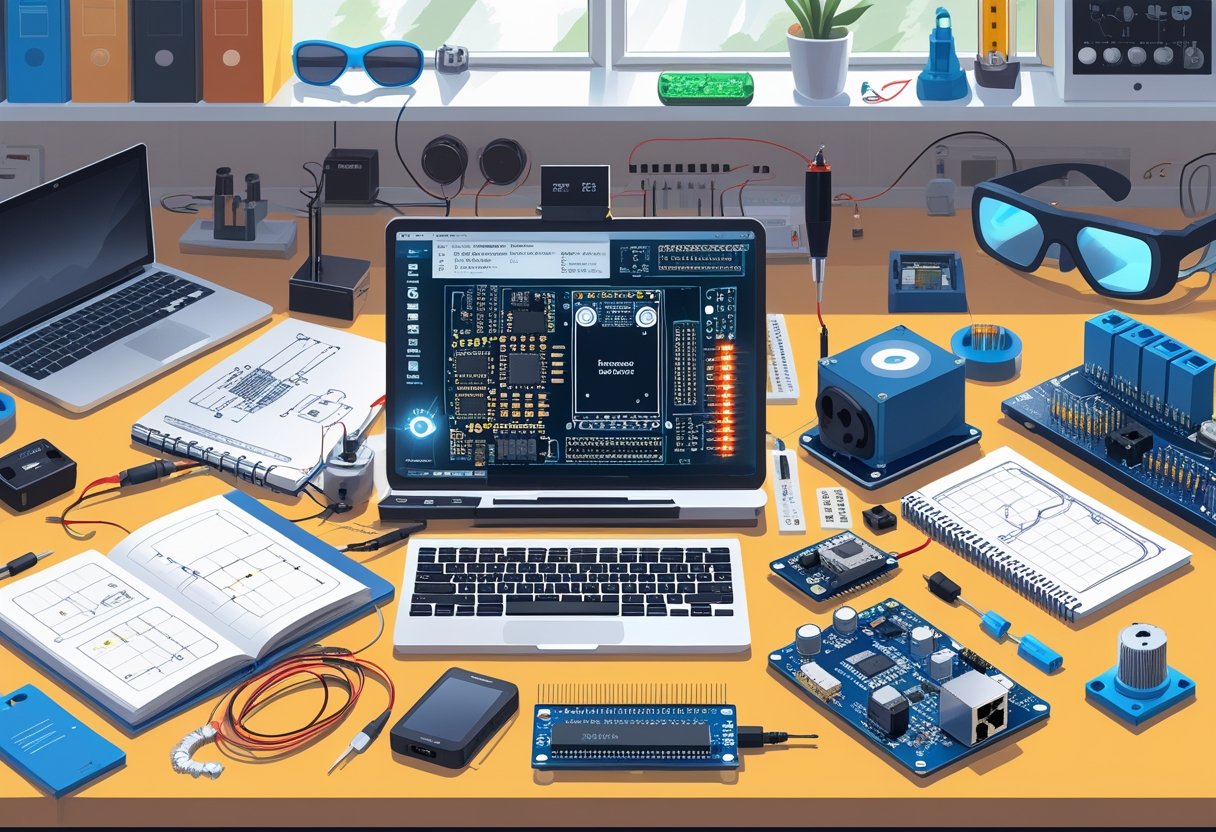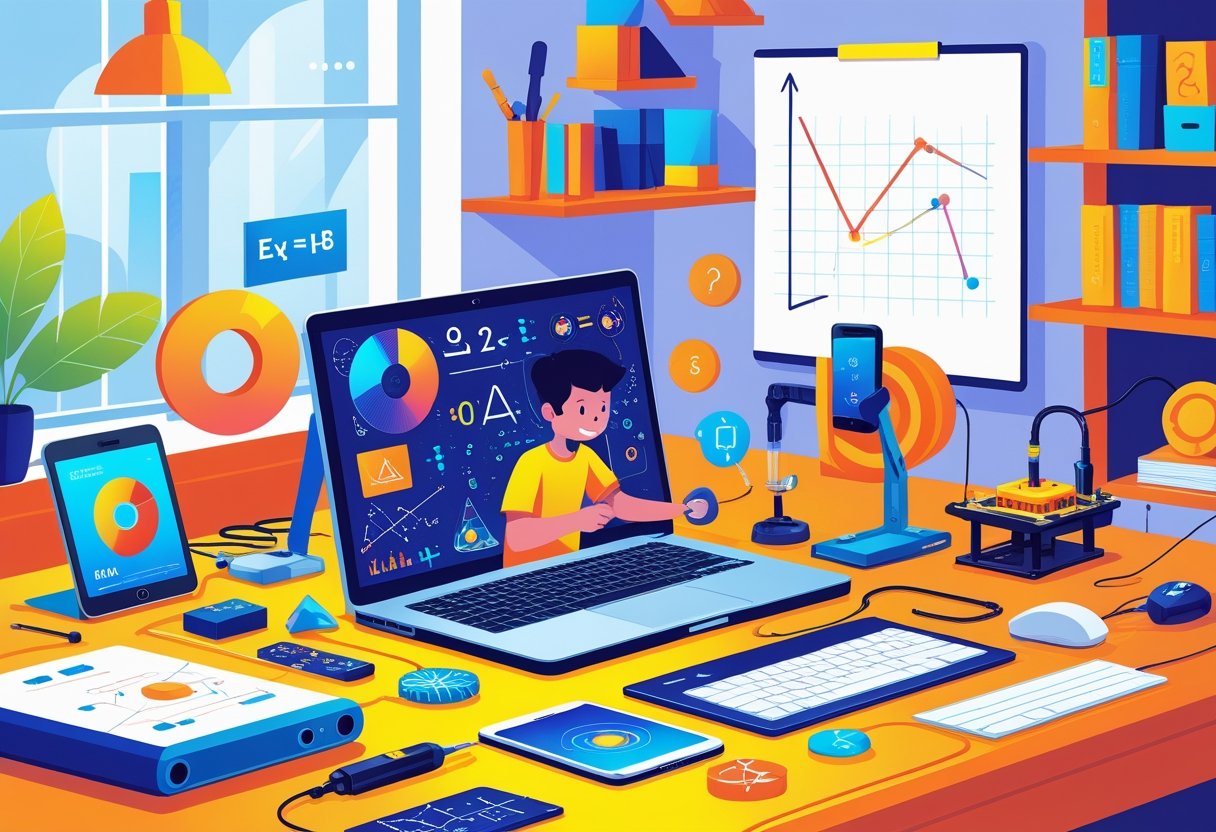In a world where technology is constantly evolving, many of us have old smartphones, tablets, or laptops tucked away in drawers. These forgotten gadgets are perfect for creative STEM learning without spending extra money. Transforming your existing tech into educational tools not only teaches valuable science, technology, engineering, and math concepts but also gives new life to devices you already own.

I’ve discovered that even basic household tech can power amazing learning experiences for both children and adults. Old smartphones can become microscopes with a simple drop of water, while tablets transform into coding stations with free apps. These projects build critical thinking skills while making learning tangible and interactive.
Key Takeaways
- Repurposing existing tech gadgets for STEM projects promotes sustainability while teaching valuable skills without additional cost.
- Simple household devices can be transformed into powerful learning tools for coding, engineering, and scientific exploration.
- Creating and sharing DIY tech projects helps develop collaborative skills and builds confidence in solving real-world problems.
Essential Tech Gadgets for DIY STEM Projects

Many exciting STEM projects can be created using common items already found in your home. I’ve identified the most versatile electronics, basic tools, and important safety considerations to help you get started without purchasing expensive specialty equipment.
Common Household Electronics
Smartphones and tablets serve as the foundation for numerous STEM projects, functioning as measurement tools, controllers, or data collection devices. I’ve found that an old smartphone can be repurposed as a microscope by using a simple water droplet on the camera lens.
Basic computers or laptops offer programming capabilities for beginners and advanced users alike. Even older models work perfectly for coding projects and simple robotics control.
TV remotes, old toys with circuits, and broken electronic devices provide valuable components like LEDs, resistors, and small motors. DIY STEM kits often use similar parts that you can salvage yourself.
Digital cameras, even older models, are perfect for time-lapse photography projects or documenting experimental results.
Basic Tools and Materials
Essential hand tools:
- Screwdriver set (Phillips and flathead)
- Needle-nose pliers
- Wire cutters/strippers
- Measuring tape or ruler
- Multimeter for testing circuits
Adhesives like hot glue, tape (electrical, masking, and duct), and craft glue allow for quick prototyping. I recommend keeping a variety on hand as different projects require different bonding strengths.
Common household items like cardboard, paper clips, rubber bands, and craft sticks form the structure of many projects. These materials are ideal for creating mechanisms like simple robots or 3D printing pen designs.
Basic electrical components including batteries, wires, and switches can power most beginner circuits. Even a lemon or potato can serve as a battery for simple demonstrations!
Safety Tips for Working with Gadgets
Always unplug devices before disassembling them to avoid electric shock. I recommend removing batteries from portable electronics before taking anything apart.
Wear appropriate safety gear including eye protection when cutting wires or working with tools. Gloves can prevent cuts when handling sharp components from disassembled gadgets.
Create a designated work area away from food, pets, and small children. Small components can be choking hazards and some electronic parts contain harmful materials if ingested.
Store tools properly after use and dispose of electronic waste responsibly. Many electronic components contain hazardous materials that shouldn’t go in regular trash.
Keep a first aid kit nearby for minor cuts or burns that might occur during soldering or hot glue use.
Creative Coding Activities with Old Devices

Older tech devices can be transformed into powerful coding education tools without purchasing new equipment. These repurposed gadgets offer hands-on learning experiences that teach fundamental programming concepts while extending the useful life of technology.
Repurposing Smartphones and Tablets
Old smartphones and tablets make excellent coding platforms for beginners. I recommend downloading free apps like Scratch Jr for younger children, which uses visual block-based coding to create simple animations and games. For older kids, Pocket Code offers a more advanced mobile coding environment.
Don’t have internet? No problem! Many coding apps work offline once installed. Apps like Grasshopper teach JavaScript fundamentals without requiring constant connectivity.
Try this quick project: Turn an old tablet into a digital storybook creator by using ScratchJr to program interactive elements for each page. Children can design characters, add movement, and record their voices to bring stories to life.
Old devices can also run simple robotics apps that pair with DIY cardboard robots, creating an engaging STEM activity that combines physical building with digital programming.
Using Laptops for Programming Experiments
Older laptops remain valuable tools for more intensive coding experiences. I’ve found that even decade-old computers can run lightweight programming environments like Python and basic web development tools.
Begin with browser-based platforms like CodePen or Repl.it that require minimal processing power. These environments allow experimentation with HTML, CSS, and JavaScript without taxing older hardware.
For offline options, install lightweight code editors like Visual Studio Code or Sublime Text. These run efficiently on older machines while providing professional-level coding environments.
Project idea: Create a simple weather station by connecting sensors to your old laptop. Use Python to collect temperature data and display it through a basic web interface you code yourself.
Old laptops work perfectly for learning algorithm concepts through visual tools like Flowgorithm, which translates flowcharts directly into multiple programming languages.
Developing Simple Apps with Kids
Creating actual applications provides deeply engaging learning experiences for children. I begin by helping kids identify problems they want to solve through technology. This approach makes coding immediately relevant and applicable.
For younger children (8-12), MIT’s App Inventor offers an intuitive block-based interface that works on older browsers. Kids can design and build functional Android apps without typing code. Their completed apps can be installed directly onto older tablets or phones.
Simple starter projects include:
- Custom calculator apps
- Digital journals with password protection
- Basic games like quizzes or memory matches
- Customized alarm clocks
For teens, introduce HTML and JavaScript for building web apps that run on any device. Start with a simple to-do list application to teach data storage concepts.
Remember to emphasize iterative development. Encourage kids to start with a basic working version, then gradually add features as their skills improve.
Engineering Projects Using Everyday Tech

Transforming common household technology into engineering projects offers hands-on learning experiences while making use of items you already own. These projects develop critical thinking skills and provide practical applications of STEM concepts without requiring expensive specialized equipment.
Building Simple Circuits with Battery-Powered Devices
I’ve found that old flashlights, toys, and remote controls contain valuable components perfect for circuit building. Start by carefully disassembling an unused battery-powered device to extract its switches, LEDs, and other electronic parts.
Create a basic circuit using a battery holder, some wire, and an LED from an old toy. Connect the positive terminal to one side of the LED and the negative terminal to the other through a small resistor to prevent burnout.
For more advanced projects, I recommend building a touch-activated light using aluminum foil as a capacitive sensor. When connected to a battery and LED, touching the foil completes the circuit.
Try constructing a homemade conductivity tester using a 9V battery, two wires, and a small buzzer or light. This simple tool can test which household materials conduct electricity.
Constructing DIY Robots from Unused Gadgets
Old electronic toys provide excellent materials for DIY robot construction. I’ve repurposed motors from broken RC cars to create simple vibrating robots that move across flat surfaces.
Materials needed:
- Motors from old toys/devices
- Battery holders
- Switches from unused gadgets
- Creative housing (plastic containers, cardboard)
- Connecting wires
Create a “bristlebot” by attaching a small motor and battery to a toothbrush head. The vibration causes the bristles to move the robot in unpredictable patterns.
For a more advanced project, combine motors from multiple devices to build a wheeled robot with directional control. Use a TV remote as a controller by reprogramming it to send signals to light sensors on your robot.
Designing Remote-Controlled Inventions
I’ve created several remote-controlled devices using components from old wireless toys. Start with a simple project like converting a wired device to wireless operation using parts from an old RC toy.
Design a remote-controlled light system by connecting LEDs to the receiver board from an old RC car. This allows you to turn lights on and off from across the room.
For a more challenging project, build a robotic arm using servos from old electronic toys. Control it with a modified TV remote or game controller.
Experiment with distance sensors from old automatic toys to create obstacle-avoiding vehicles. These can be programmed to navigate around objects without human intervention.
Remember that safety comes first when working with electronics. Always disconnect power sources before making modifications and avoid projects requiring high voltage.
Science Experiments Leveraging Home Gadgets

Your household technology can transform into powerful scientific tools with just a bit of creative thinking. Many everyday electronics contain sensors, components, and capabilities that enable fascinating STEM experiments without buying specialized equipment.
Measuring Environmental Data with Sensors
Most smartphones contain multiple sensors that can be harnessed for scientific experiments. Using free apps like Physics Toolbox or Science Journal, I can measure light intensity, sound levels, and even magnetic fields around my home.
Older fitness trackers can be repurposed to monitor environmental changes over time. By placing them in different locations, I can track temperature variations throughout my house, identifying insulation issues or heat sources.
Smart home devices like weather stations or smart thermostats provide valuable data logging capabilities. I can export this data to spreadsheets and create graphs showing how humidity, temperature, and air pressure change with weather patterns or household activities.
Exploring Physics with Old Cameras
Digital cameras and webcams make excellent tools for studying motion and light. By setting up time-lapse photography, I can document plant growth, cloud movements, or shadow patterns throughout the day.
Old smartphone cameras can be converted into microscopes with a drop of water placed on the lens. This simple hack lets me explore the microscopic world of household dust, food textures, or fabric fibers at amazing magnification levels.
For studying motion physics, I use smartphone slow-motion video features to capture and analyze events too quick for the human eye. Dropping objects, pendulum swings, or water splashes become fascinating subjects for measuring velocity and acceleration.
Testing Chemistry Reactions Using Kitchen Tech
Digital kitchen scales provide precise measurements for chemical experiments. I can conduct acid-base reactions using household vinegar and baking soda, measuring exact quantities to determine optimal ratios for maximum reaction.
My blender and food processor demonstrate physical mixing properties and emulsions. I can test how different ingredients combine or separate based on their molecular properties and document these changes with smartphone photography.
A microwave reveals interesting properties of different materials. Testing which substances heat quickly versus slowly demonstrates molecular excitation principles. Caution is necessary, but safe experiments include heating water with different dissolved substances to observe boiling point changes.
Smart cooking devices with temperature probes allow precise monitoring of thermal reactions. I can track how different solutions cool at varying rates, demonstrating principles of specific heat capacity with everyday kitchen technology.
Mathematics Projects Powered by Technology

Technology transforms abstract math concepts into hands-on learning experiences using devices most families already own. These projects help children visualize mathematical principles while developing problem-solving skills through interactive engagement.
Interactive Math Games on Tablets
Tablets and smartphones offer excellent platforms for mathematical exploration through apps designed specifically for learning. I recommend downloading free apps like Prodigy Math, which gamifies math practice through quests and battles that adjust to your child’s skill level.
Khan Academy Kids provides interactive exercises that teach number sense and basic operations through colorful animations and immediate feedback. These apps track progress, allowing parents to identify areas needing additional support.
For older children, try DragonBox Algebra, which cleverly introduces algebraic concepts through puzzle-solving without overwhelming formulas. This app builds mathematical thinking gradually through play.
Creating a weekly “math app time” of just 15-20 minutes can significantly improve mathematical fluency and confidence. Many children who struggle with traditional worksheets thrive with these technology projects for kids.
Visualizing Geometry with Projection Devices
Home projectors or document cameras can transform geometry learning by creating large-scale mathematical visualizations on walls or floors. I’ve found this approach particularly effective for kinesthetic learners.
Project a coordinate plane onto a large surface and use toys or household objects to plot points, demonstrating concepts like distance and slope. Children can physically walk through these problems, making abstract ideas concrete.
Try creating shadow geometry by placing objects at different distances from a light source. This activity teaches scale, proportion, and perspective in an engaging way.
For a more advanced project, use a smartphone with a projector to display GeoGebra illustrations, allowing children to interact with dynamic geometry constructions. They can manipulate angles, explore symmetry, and visualize transformations through movement.
These STEM projects with simple materials help children develop spatial reasoning skills critical for mathematical development.
Data Collection with Smart Home Accessories
Smart home devices offer unique opportunities for real-world data collection and analysis projects. I encourage setting up simple experiments using smart thermostats to track temperature changes throughout the day or week.
Children can record data in spreadsheets, calculate averages, identify patterns, and create graphs that visualize their findings. This combines mathematics with scientific inquiry and technological literacy.
Voice assistants can be programmed to quiz children on math facts or help with measurement conversions during cooking projects. These activities incorporate math into daily routines.
Fitness trackers provide personal data for analyzing step counts, heart rates, or sleep patterns. Children can calculate percentages, find means and medians, and identify correlations between different variables.
These no-prep STEM activities develop critical thinking skills by connecting mathematical concepts to real-world applications using technology already in the home.
Art and Design STEM Challenges with Available Tech
Technology devices we already own offer incredible opportunities to explore the creative side of STEM education. These projects combine artistic expression with technical skills, helping develop both sides of the brain while using everyday tech.
Digital Illustration Using Touchscreens
Tablets and smartphones can transform into powerful art studios with the right approach. I recommend starting with free apps like Procreate Pocket, Adobe Sketch, or even the built-in drawing tools on many devices.
Try creating digital art that incorporates mathematical concepts like symmetry or geometric patterns. For younger creators, experiment with finger painting apps that teach color theory while developing fine motor skills.
A fun challenge is to design optical illusions that demonstrate principles of perspective and visual perception. The zoom feature on touchscreens allows for incredible detail work that would be difficult with traditional media.
Connection to STEM learning happens when you explore the technical aspects behind digital art – like how pixels form images and how color mixing works differently in digital (RGB) versus physical (CMYK) environments.
Creating Stop Motion Animation with Webcams
Webcams on laptops or phones can capture frame-by-frame animation sequences with minimal setup. I’ve found that free software like Stop Motion Studio makes this accessible even for beginners.
Start with simple projects using household objects or paper cutouts. The technical challenge involves calculating how many frames are needed for smooth movement (typically 12-24 frames per second).
This activity brilliantly combines storytelling with engineering concepts like stability and motion. Children learn about persistence of vision – the optical illusion that makes animation possible.
Lighting experiments add another STEM dimension – observe how different light sources affect shadow and contrast. The digital nature of the process allows for immediate feedback and iteration, reinforcing the scientific method of hypothesis, testing, and refinement.
Collaboration and Sharing Your STEM Creations
STEM projects gain tremendous value when shared with others through proper documentation, presentation, and community engagement. These practices enhance learning and inspire others to participate in similar tech explorations.
Documenting Projects with Video and Photography
Capturing your STEM creations visually preserves your work and helps others understand your process. I recommend using your smartphone’s camera to document key stages of your project – not just the final result.
Time-lapse videos work particularly well for showing gradual builds, while close-up photos highlight intricate details. When photographing electronic components, use good lighting to ensure clarity.
Create a simple shot list before starting:
- Materials and tools layout
- Step-by-step assembly
- Testing phases
- Final demonstration
Consider narrating your process using your phone’s voice recorder or adding text overlays to photos. This documentation becomes invaluable when sharing with teachers, friends or online communities.
Presenting Results Using Projectors and Smart TVs
Modern homes typically contain at least one device perfect for showcasing STEM projects to family and friends. I’ve found connecting laptops to TVs via HDMI cables offers the simplest setup for presentations.
For wireless options, try:
- Chromecast: Stream directly from most devices
- Apple TV/AirPlay: Ideal for Apple ecosystem users
- Bluetooth/WiFi Direct: Available on many smart TVs
When presenting, organize your content in logical segments. Start with your hypothesis or goal, show your process, and demonstrate the results. Interactive demonstrations gain more engagement than static displays.
Use your TV’s screen mirroring feature to show real-time data from sensors or electrical projects. This works particularly well for coding projects where you can showcase both the code and its execution.
Connecting with Online STEM Communities
Sharing projects online expands your learning network exponentially. I recommend starting with established platforms where STEM enthusiasts already gather.
Top STEM communities:
- Instructables: Perfect for step-by-step project guides
- GitHub: For sharing code and technical documentation
- Reddit (r/DIY, r/STEM, r/electronics): Great for feedback
- YouTube: Ideal for demonstration videos
When posting, include clear titles and detailed descriptions of materials, challenges, and solutions. Be specific about which household technologies you repurposed.
I’ve found that asking specific questions encourages more meaningful responses than generic requests for feedback. Communities often provide solutions to problems you haven’t even considered and might suggest valuable improvements to your design.
Frequently Asked Questions
Parents and educators often seek creative ways to engage children with technology through hands-on learning. These practical questions address how to leverage existing household tech for meaningful STEM activities across different age groups.
What are some fun and educational DIY tech projects I can do with my children using items we have at home?
You can create a simple circuit using aluminum foil, batteries, and LED lights to teach electrical concepts while making a light-up greeting card. This introduces basic circuitry in a creative way.
Another engaging project is building a homemade projector using a smartphone, magnifying glass, and a shoebox. This demonstrates principles of optics while creating something functional.
Turn old electronic toys into new inventions by safely disassembling them and repurposing the parts. This makes learning about electronics hands-on while encouraging creative problem-solving.
How can I incorporate common household technology into impactful STEM learning activities for middle school students?
Middle schoolers can build simple robots using old electric toothbrushes, batteries, and small motors. This “bristlebot” project teaches circuitry and engineering principles with immediate visual results.
Create a home weather station using a smartphone with weather apps, thermometers, and homemade wind indicators. Students can track data over time, introducing concepts of scientific observation and data analysis.
Design smartphone apps using free development platforms that solve household problems. This connects programming skills to real-world applications while using technology they’re already familiar with.
What creative STEM project ideas can be executed with simple gadgets at home for high school students?
High school students can build a basic AI chatbot using free online tools like Google’s Dialogflow. This introduces programming and artificial intelligence concepts while creating something interactive.
Creating a smartphone-powered microscope using the phone’s camera and a drop of water can explore biology at the microscopic level. This transforms an everyday device into a scientific instrument.
Building a home automation system using microcontrollers like Arduino (if available) or smart home apps teaches programming, electronics, and practical engineering. Students can automate lights or build environmental monitors.
What resources are available for parents to conduct STEM experiments with their kids using everyday technology?
The National PTA offers extensive STEM at Home Activities that use common household items. These resources include step-by-step guides for various age levels.
Educational companies like Sylvan Learning provide DIY STEM project guides specifically designed for kitchen-counter science using everyday technology.
Many science museums have online resources with virtual exhibits and at-home experiment guides that incorporate common technology. These typically include comprehensive instructions with educational context.
Could you suggest entry-level technology projects that can be used to introduce basic STEM concepts to young learners?
Create a simple “squishy circuit” using LED lights, batteries, and conductive and insulating play dough. This introduces electrical concepts through tactile play appropriate for young children.
Build a basic coding sequence using household objects. Have children arrange paper arrows to “program” a family member to move through an obstacle course, introducing programming logic without screens.
Make a homemade flashlight using copper tape, batteries, and LED lights. This project introduces circuitry with immediate practical application that young learners can be proud of.
What are the most engaging do-it-yourself STEM activities that utilize widely-available household tech items?
Building a smartphone hologram projector using clear plastic, scissors, and a smartphone engages learners with principles of light reflection while creating a visually stunning result.
Creating digital storytelling projects using smartphones to film stop-motion animation teaches principles of physics, art, and technology integration. This combines creativity with technical skills.
Designing and testing paper airplanes while using smartphone apps to measure flight distance and time introduces aerodynamics and data analysis. SAM Labs suggests these types of creative indoor and outdoor STEM activities that combine physical objects with digital measurement.
